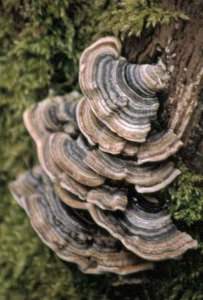Before I got into medicinal mushrooms I had never heard of polysaccharides or beta-glucans, but these compounds are not unique to fungi, and instead are widely pervasive.
There are very different functions among polysaccharides and even beta-glucans. The aim of this article is to clear up the topic.
Polysaccharides are carbohydrates. The name means many (poly) sugars (saccharides).
But they are not like your monosaccharides like glucose and fructose or disaccharides like sucrose, common table sugar. When more and more of these and other sugar molecules are linked together the function changes.
Polysaccharides are primarily used for two purposes, as structural components and for the storage of energy (which later get broken down into simpler sugars to be used energy purposes).
Cellulose is a polysaccharide. Because of its many molecules and structure we humans can’t digest it for energy. Most fibers fit in this group, some digestible, some not, some only by our microbiome.
Starch is also a polysaccharide, structurally an alpha-glucan. This is what many people think of as complex carbs. It is the energy storage for plants. And in us humans and animals we use a slightly different form called glycogen, the animal equivalent.
So polysaccharides are a BIG group of many varied things. Some of which have very different health effects than others.
What are Beta-Glucans?
So let’s narrow in on beta-glucans which are a sub-group of polysaccharides.
Beta-glucans are natural components of cell walls found in cereal grains, yeasts and fungi. They’re part of the structure, but that is not their sole purpose. As you can imagine those found in these different organisms are fairly different.
Beta-1,3 and Beta-1,4 glucans are those that are commonly found in cereal grains, most notably oats and barley, with much smaller amounts in wheat and rye. These are also found in some seaweeds and many mushrooms.
The Beta-1,6 glucans are found mostly in fungi. This is what gives at least some of the benefits attributed to many of the medicinal mushrooms.
Mushroom Beta-Glucans
“The orally active, protein-bound polysaccharides, and polysaccharide derivatives can be viewed as precursor-nutrients, awakening the immune system, activating macrophages and gene expression of cytokines.”
– Paul Stamets in Mycomedicinals [1]
When consumed, these are absorbed in the digestive tract and make their way in the circulating blood where they can then exert effects throughout the body.
Some of the beneficial components of the medicinal mushrooms, and also other herbs, are in the forms of polysaccharides. Remember that beta glucans form a group, of which there are many individual types.
One specific type of protein bound beta-glucan, Polysaccharide-K (also known as PSK or Krestin) is found in the Trametes versicolor mushroom, better known as turkey tail. Also found in this mushroom is Polysaccharide peptide (PSP). Both of these are being heavily investigated for their anticancer properties.[2]

Those from Reishi are called ganoderan and ganopoly. Shiitake has lentinans. Many others, in chaga, cordyceps, lion’s mane, and other musrhooms, have not been specifically named.
“Polysaccharides from mushrooms showing a β-linkage have demonstrated a boost in the human immune system and the modulation of the immunological response under certain circumstances, thus they are commonly termed biological response modifiers (BRM).” [3]
That means that these help your body, specifically your immune system to respond better to threats.
Extraction and Quantities of Beta-Glucans
Most of the polysaccharides are water soluble meaning that they are extracted in decoctions or other water extraction methods. However, there are some that are water insoluble.
Whereas water extracts are best for getting these polysaccharides, alcohol is often used to bring out some of the other components that are not extracted by water alone such as triterpenes and various acids.
Although a fair amount of research has been investigating these, there is much more to be done.
In regards to the quality of mushroom supplementation, one of the issues with these beta-glucans is that with mycelium grown on grain, a lot of the beta-glucans included may not be from the mushrooms, but instead the grain. Recent research has looked to find the best way to isolate for testing purposes the biologically active mushroom beta-glucans.[4]
Those from grain do not have the same effects that those from the mushrooms do. Thus it is important to use fruiting bodies from mushrooms.
Also it is important to not that while we have focused on the beta-glucans and polysaccharides from mushrooms, plenty of other foods and herbs have different beneficial versions of these as well.
We’ll be having more articles in the future focusing on specific types as well as many other beneficial components found in mushrooms and elsewhere.
References:
- Cheng, K., Leung, P., (2008) General review of polysaccharopeptides (PSP) from C. versicolor: Pharmacological and clinical studies. Cancer Therapy Vol 6, 117-130.
- Yang, Qi, Mitochondria and Chronic Fatigue - March 27, 2024
- Eczema: A Natural Approach to Soothing Your Skin - March 10, 2024
- Harmless vs. Pathogenic E. coli - February 27, 2024


Love it. Thanks a bunch. I am going to use it and pass it on.
That is the best thing we could hear. Thank you Sarah!
A good source of beta glucans & polysaccharides comes from the aloe plant, but requires special handling. It needs to be freeze dried soon after it’s cut to maintain its maximum benefits. The same is true with much of the fruit & produce we consume.
Thanks for sharing!
WOW. Cool.